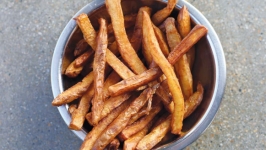Going the Distance
Mario Lombardi plans to celebrate his 104th birthday in December. But before he makes specific party plans he wants to plant a garden and tackle harvest season. The Twin Falls transplant credits 103 years of farm-to-table eating, plenty of time outdoors and a blissful 65-year marriage for his long life.
“We did everything together,” the great-grandfather says of his late wife. The pair spent much of their time together outside, playing tennis, exercising and digging in the dirt. Lombardi still digs in the dirt and he’d still be driving his car around Twin Falls if other motorists weren’t so careless, he says.
Not everyone can count on marital bliss as a pathway to membership among the growing number of Idaho centenarians, but we’ve all got stomachs to fill and researchers think Lombardi’s plate might hold the secret to a long and healthy life.
University of Idaho nutritionists took a closer look at the diets of centenarians, including Lombardi and others from around the world, to look for clues to the equation that equals a long life. So far, the research points to protein.
Americans often bulk up on protein but a high-protein diet alone isn’t likely to get you to a three-digit birthday. The secret is to spread your consumption of protein throughout the day, according to two Idaho-based researchers.
U of I associate professor and nutritionist SeAnne Safaii and her research partner, nutritional gerontologist Sue Linja, traveled the world from Hiroshima, Japan, to Sardinia, Italy, and back to Idaho to try to determine the kind of diet that fuels 100-plus years of healthy life. They found that it’s not just about what you eat, but how you eat it.
“If you think about how the elderly eat in the United States, what do they do? They go to Chuck-A-Rama for dinner or one of those buffets and have one big meal. The elderly in Italy and Japan that we studied don’t do that. They eat three to four meals throughout the day and they are high in protein.”
And those meals look a lot like what Lombardi eats. Much of his backyard bounty makes it into the Italian soups that remain the cornerstone of his diet.
“I eat a lot of everything,” he says. Safaii found that the centenarians she studied do the same thing. They garden. They eat a lot of soup. And what comes from the garden bulks up those soups along with vegetable-based proteins. Lentil-rich minestrones round out the daily diets of the Italians Safaii studied and the aged in Japan eat a diet rich in tofu and vegetable-stocked miso soup. Both groups ate bounties of vegetables and in Italy, the day often started with Greek yogurt while fish made regular appearances on morning menus in Japan.
What didn’t Safaii find a lot of on the plates of her centenarian subjects? Meat.
“The beef council kind of got mad at me for all of this work,” Safaii joked. But Idaho lentil growers might send Safaii some thank you notes. The humble protein-packed legume figured prominently in the diets of the centenarians Safaii studied. Beans made their way into minestrone soups, soy proteins bulked up miso meals and pod-bearing vegetables crawled through the gardens of her elderly subjects.
Idaho’s Palouse region yields some of the largest lentil harvests in the country, making it easy to eat local while eating protein-dense foods. Safaii suggests topping a baked potato with spicy lentils for a filling and protein-rich dinner. Or do as the Sardinians and Lombardi do and plant a garden for seasons of vegetable and lentil soups.
Longstanding dietary recommendations advise that people eat 0.8 grams of protein per kilogram of weight. Safaii says that doesn’t need to change—the protein, roughly 25 to 30 grams of it, should just become a part of every meal.
The protein distribution becomes especially important in middle age when people start to lose muscle mass that can lead to falls and bone fractures, Safaii says.
“We’re just not as efficient at utilizing the amino acids to build muscle and we slowly start losing our ability to build muscle,” Safaii says. “Otherwise there would be Olympic athletes in their 50s and 60s.”






